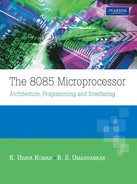Contents
Part I FUNDAMENTALS OF A MICROPROCESSOR
1. Evolution of Microprocessors
1.7 Microcontrollers and Digital Signal Processors
3.3 Representation of Fractions
3.4 Signed Floating Point Numbers
4. Fundamentals of Microprocessor
4.1 History of Microprocessors
4.3 Programmer's View of 8085: Need for Registers
4.5 Registers B, C, D, E, H, And L
5. First Assembly Language Program
5.2 About the Microprocessor Kit
5.3 Using the Microprocessor Kit in Serial Mode
6. Data Transfer Group of Instructions
6.1 Classification of 8085 Instructions
6.2 Instruction Type MVI r, d8
6.3 Instruction Type Mov r1, r2
6.6 Instruction Type LXI rp, d16
6.7 Instruction Type MVI m, d8
6.14 Instruction Type LHLD a16
6.15 Instruction Type SHLD a16
7. Arithmetic Group of Instructions
7.1 Instructions to Perform Addition
7.2 Instructions to Perform Subtraction
8. Logical Group of Instructions
8.1 Instructions to Perform ‘and’ Operation
8.2 Instructions to Perform ‘or’ Operation
8.3 Instructions to Perform ‘EXCLUSIVE OR’ Operation
8.4 Instruction to Complement Accumulator
8.5 Instructions to Complement/Set ‘Cy’ Flag
8.6 Instructions to Perform Compare Operation
8.7 Instructions to Rotate Accumulator
9. NOP and Stack Group of Instructions
9.1 Stack and The Stack Pointer
9.4 Instruction Type LXI sp, d16
10. Branch Group of Instructions
10.1 More Details about Program Execution
10.2 Unconditional Jump Instructions
10.3 Conditional Jump Instructions
10.4 Unconditional Call and Return Instructions
10.5 Conditional Call Instructions
10.6 Conditional Return Instructions
10.7 RSTN – Restart Instructions
11.1 Concept of Chip Selection
11.2 RAM Chip–Pin Details And Address Range
11.3 Multiple Memory Address Range
11.4 Working of 74138 Decoder IC
11.5 Use of 74138 to Generate Chip Select Logic
11.6 Use of 74138 in ALS-SDA-85M Kit
12.5 Comparison of Memory-Mapped I/O and I/O-Mapped I/O
13.1 Details of 8085 Architecture
13.3 Comparison of Different Machine Cycles
Part II ASSEMBLY LANGUAGE PROGRAMS
14. Simple Assembly Language Programs
14.2 Add two Multi-Byte Numbers
14.3 Add two Multi-Byte BCD Numbers
14.4 Block Movement without Overlap
14.5 Block Movement with Overlap
14.6 Add N Numbers of Size 8 Bits
14.7 Check the Fourth Bit of a Byte
14.8 Subtract two Multi-Byte Numbers
14.9 Multiply two numbers of Size 8 Bits
14.10 Divide a 16-Bit Number by an 8-Bit Number
15. Use of PC in Writing and Executing 8085 Programs
15.1 Steps Needed to Run an Assembly Language Program
15.2 Creation of .ASM File using a Text Editor
15.3 Generation of .OBJ File using a Cross-Assembler
15.4 Generation of .HEX File using a Linker
15.5 Downloading the Machine Code to the Kit
15.6 Running the Downloaded Program on the Kit
15.7 Running the Program using the PC as a Terminal
16. Additional Assembly Language Programs
16.1 Search for a Number using Linear Search
16.3 Compute the HCF of Two 8-Bit Numbers
16.4 Check for ‘2 out of 5’ Code
16.10 Compute the LCM of Two 8-Bit Numbers
16.11 Sort Numbers using Bubble Sort
16.12 Sort Numbers using Selection Sort
16.13 Simulate Decimal up Counter
16.14 Simulate Decimal down Counter
16.15 Display Alternately 00 and FF in the Data Field
16.16 Simulate a Real-Time Clock
17. More Complex Assembly Language Programs
17.1 Subtract Multi-Byte BCD Numbers
17.2 Convert 16-Bit Binary to BCD
17.3 Do an operation on two Numbers Based on the Value of X
17.4 Do an operation on Two BCD Numbers Based on the Value of X
17.5 Bubble Sort in Ascending/Descending Order as per Choice
17.6 Selection Sort in Ascending/Descending Order as per Choice
17.7 Add Contents of N Word Locations
17.8 Multiply Two 8-Bit Numbers (Shift and Add Method)
17.9 Multiply two 2-Digit BCD Numbers
17.10 Multiply two 16-Bit Binary Numbers
Part III PROGRAMMABLE AND NON-PROGRAMMABLE I/O PORTS
18.2 General Discussion about 8085 Interrupts
18.8 Execution of ‘DAD rp’ Instruction
18.11 Programs using Interrupts
19. 8212 Non-Programmable 8-Bit I/O Port
20. 8255 Programmable Peripheral Interface Chip
20.2 Operational Modes of 8255
20.5 Mode 2-Bi-Directional I/O
21. Programs using Interface Modules
21.1 Description of Logic Controller Interface
21.2 Successive Approximation ADC Interface
21.4 Digital to Analog Converter Interface
22. Interfacing of I/O Devices
22.1 Interfacing 7-Segment Display
22.2 Display Interface using Serial Transfer
22.3 Interfacing a Simple Keyboard
22.4 Interfacing a Matrix Keyboard
22.5 Description of Matrix Keyboard Interface
22.6 Intel 8279 Keyboard And Display Controller
23. Intel 8259A—Programmable Interrupt Controller
23.1 Need for an Interrupt Controller
23.2 Overview of the Working of 8259
23.5 Programming the 8259 with no Slaves
23.6 Programming the 8259 with Slaves
23.7 Use of 8259 in an 8086-Based System
24. Intel 8257—Programmable DMA Controller
24.1 Concept of Direct Memory Access (DMA)
24.2 Need for DMA Data Transfer
24.3 Description of 8257 DMA Controller Chip
24.5 Description of the Pins Of 8257
24.6 Working of the 8257 DMA Controller
25. Intel 8253—Programmable Interval Timer
25.1 Need for Programmable Interval Timer
25.2 Description of 8253 Timer
25.4 Mode 0–Interrupt On Terminal Count
25.5 Mode 1–Re-Triggerable Mono-Stable Multi
25.7 Mode 3–Square Wave Generator
25.8 Mode 4–Software-Triggered Strobe
28.9 Mode 5–Hardware-Triggered Strobe
28.10 Use of 8253 in ALS-SDA-85 Kit
26. Intel 8251A—Universal Synchronous Asynchronous Receiver Transmitter (USART)
26.2 Asynchronous Transmission
26.6 Pin Description of 8251 USART
26.8 Use of SOD Pin of 8085 for Serial Transfer
27.1 Comparison of Intel 8080 with Intel 8085
27.2 Programmer's View of Z-80
27.5 Special Instruction Types
27.7 Interrupt Structure in Z-80
28. Motorola M6800 Microprocessor
28.2 Programmer's View of 6800
29.1 Main Features of Intel 8051
29.2 Functional Blocks of Intel 8051
29.5 Programmer's View of 8051
30.1 Interrupt Structure of 8051
30.4 Structure and Operation of Ports
30.5 Power Saving Modes of 8051
